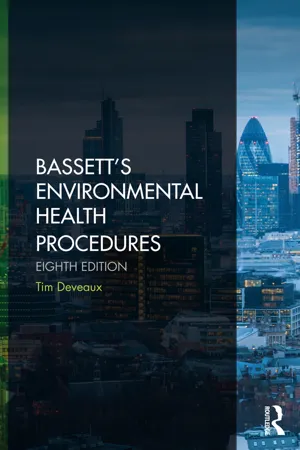
- 656 pages
- English
- ePUB (mobile friendly)
- Available on iOS & Android
Bassett's Environmental Health Procedures
About this book
Environmental health law is a wide-ranging, detailed and complex body of law within the UK. Environmental Health Procedures is an established and essential reference source which provides an accessible entry into enforcement and administrative procedures for environmental health. The main legal procedures used in the environmental health field are presented as flow charts supported by explanatory text.
The structure of this eighth edition has been revised for ease of use, with each chapter now addressing a single topic instead of a piece of legislation. It also introduces legal guidance for environmental health practitioners to prepare them for the court prosecutions that are an essential part of their work. The book has been updated throughout to reflect new practices, legislation and statutory guidance including:
- Primary Authorities
- Authorisations for public water supplies
- Infectious disease control
- Port Health
- RIDDOR
- Environmental permitting
- Environmental damage
- Imported food
- Empty homes
- Licensing of housing
- Licensing of gambling activities
-
Environmental Health Officers/Practitioners and students will find this bookinvaluable. It will also be an essentialreference for all those whose responsibilities demand they keep abreast of current environmental health practices.
Frequently asked questions
- Essential is ideal for learners and professionals who enjoy exploring a wide range of subjects. Access the Essential Library with 800,000+ trusted titles and best-sellers across business, personal growth, and the humanities. Includes unlimited reading time and Standard Read Aloud voice.
- Complete: Perfect for advanced learners and researchers needing full, unrestricted access. Unlock 1.4M+ books across hundreds of subjects, including academic and specialized titles. The Complete Plan also includes advanced features like Premium Read Aloud and Research Assistant.
Please note we cannot support devices running on iOS 13 and Android 7 or earlier. Learn more about using the app.
Information
- entrenching the system of risk assessment throughout the regulatory system;
- reducing the need for inspections by up to one third;
- reducing the number of forms regulators send out by up to 25 per cent;
- making more use of advice by applying the principle of risk assessment;
- substantially reducing the need for form filling;
- applying tougher and more consistent penalties where these are deserved;
- reducing the number of regulators that businesses have to deal with;
- entrenching reform by requiring all new policies and regulations to consider enforcement and to use existing structures wherever possible;
- creating a new business-led body at the heart of government to drive implementation of the recommendations and challenge departments on their regulatory performance.
- transparent;
- accountable;
- proportionate;
- consistent; and
- targeted only at cases in which action is needed (section 21).
- providing a centre of expertise for primary authorities and extending the scheme to enable more businesses to participate;
- simplifying delivery of regulation for business, regulators and government;
- providing a forum for business engagement to shape regulatory policy and delivery;
- supporting Local Enterprise Partnerships to tackle regulatory delivery issues at the local level;
- providing policy advice to UK and Welsh ministers on regulatory delivery.
- standards of level of service and performance;
- openness in the provision of information and the use of plain language;
- helpfulness in working with those affected by environmental health laws;
- well-publicised procedures for dealing with complaints about enforcement;
- proportionality to ensure that enforcement action is related to risk levels;
- consistency by enforcing in a fair, equitable and consistent manner;
- procedures to guide the enforcement action of individual officers.
- annual use of resources assessment;
- annual service assessment;
- a periodic corporate assessment.
- Protection of the wider agenda (i.e. councils leading and energising local communities)
- Transparency and consistency
- Quality and value
- Delivery and review.
- The standard – which sets out the requirements for the planning, organisation, management and delivery of local authority food law enforcement services.
- Service planning guidance – on matters that include: 1. Service aims and objectives2. Background3. Service delivery4. Resources5. Quality assessment6. Review.
- A monitoring scheme – which sets out the arrangements for the Agency to obtain enforcement information from the local authorities. The Agency collects key data on how each local authority is delivering feed and food law enforcement, on an annual basis. This is achieved through the Local Authority Enforcement Monitoring System (LAEMS), which was introduced in April 2008.
- An audit scheme – which provides for a rolling programme of audits by the Agency. Authorities are audited against the Feed and Food Law Enforcement Standard in the Framework Agreement, which sets out the minimum standards...
Table of contents
- Cover
- Half Title
- Title Page
- Copyright Page
- Table of Contents
- List of flow charts
- Subject index of procedures
- Preface
- Extract from the preface to the first edition
- Acknowledgements
- Chapter 1: Environmental health legal structure and process
- Chapter 2: Environmental protection Air quality
- Chapter 3: Food safety
- Chapter 4: Health and safety
- Chapter 5: Housing and health
- Chapter 6: Public health Animal welfare
- Chapter 7: Public safety